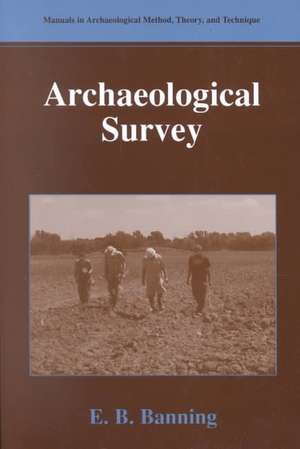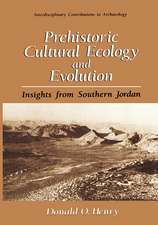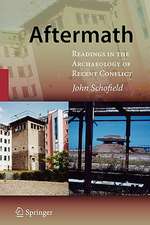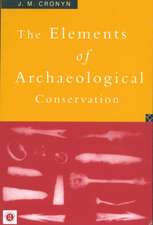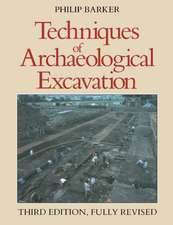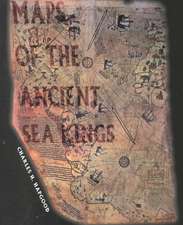Archaeological Survey: Manuals in Archaeological Method, Theory and Technique
Autor E.B. Banningen Limba Engleză Paperback – 31 oct 2002
Intended as a text for students in upper-division-undergraduate and graduate-level courses as well as a manual for professional researchers and cultural resource management practitioners, the book is abundantly illustrated and references and includes a glossary of key terms. Suggested laboratory exercises are available on the author’s university webpage:
http://homes.chass.utoronto.ca/~banning/ARH%20312/312labs.htm
| Toate formatele și edițiile | Preț | Express |
|---|---|---|
| Paperback (1) | 421.55 lei 43-57 zile | |
| Springer Us – 31 oct 2002 | 421.55 lei 43-57 zile | |
| Hardback (1) | 398.35 lei 43-57 zile | |
| Springer Us – 31 oct 2002 | 398.35 lei 43-57 zile |
Preț: 421.55 lei
Nou
Puncte Express: 632
Preț estimativ în valută:
80.69€ • 87.68$ • 67.82£
80.69€ • 87.68$ • 67.82£
Carte tipărită la comandă
Livrare economică 21 aprilie-05 mai
Preluare comenzi: 021 569.72.76
Specificații
ISBN-13: 9780306473487
ISBN-10: 0306473488
Pagini: 273
Ilustrații: XXI, 273 p.
Dimensiuni: 155 x 235 x 16 mm
Greutate: 0.42 kg
Ediția:2002
Editura: Springer Us
Colecția Springer
Seria Manuals in Archaeological Method, Theory and Technique
Locul publicării:New York, NY, United States
ISBN-10: 0306473488
Pagini: 273
Ilustrații: XXI, 273 p.
Dimensiuni: 155 x 235 x 16 mm
Greutate: 0.42 kg
Ediția:2002
Editura: Springer Us
Colecția Springer
Seria Manuals in Archaeological Method, Theory and Technique
Locul publicării:New York, NY, United States
Public țintă
ResearchCuprins
I. Introduction.- 1. A Brief History of Archaeological Survey.- 2. Survey’s Unique Contribution to Archaeology.- 3. Surface Distributions and Buried Landscapes.- 4. Research Design in Archaeological Survey.- II. The Goals of Archaeological Survey.- 1. Types of Goals.- III. The Discovery of Archaeological Materials by Survey.- 1. Factors Affecting Archaeological Detection.- 2. Estimating Discovery Probabilities.- 3. Post-depositional Factors that Affect Spatial Pattern.- 4. Summary.- IV. Units, Sampling Frames, and Edge Effects in Archaeological Survey.- 1. The Spatial Distribution of Material Culture.- 2. Boundaries of the Survey Area.- 3. Types, Shapes, and Orientation of Units.- 4. Scale Effects in Archaeological Survey.- 5. Conclusions.- V. Sampling Space: Statistical Surveys.- 1. Sampling Designs.- 2. Sample Size and Estimation.- 3. Using Samples.- 4. Conclusion.- VI. Purposive Survey: Prospection.- 1. Prospecting.- 2. Prospection to Test Models or Hypotheses.- 3. Bayesian Prospection and Operations Research.- 4. Game Theory and Linear Programming in Optimal Searches.- 5. Conclusions.- VII. Surveying for Spatial Structure.- 1. What is Spatial Structure?.- 2. “The Case for Total Survey”.- 3. How to Survey for Spatial Structure.- 4. Conclusion.- VIII. Cultural Resource Management and Site Significance.- 1. What is Cultural Resource Management?.- 2. Regional Impact assessments by Field Survey.- 3. Assessing Significance.- 4. Administrative, Ethical, and Legal Aspects of CRM.- 5. Conclusion.- IX. Surveying Sites and Landscapes.- 1. Fieldwalking and Surface Survey.- 2. Common Attributes of Sites.- 3. Examining Sites and Collecting or Recording Artifacts.- 4. Documenting “Non-Site” or “Off-Site” Material Culture.- 5. Intertidal Surveys.- 6. Controls and DataQuality.- 7. Conclusion.- X. Evaluating Surveys.- 1. Assessing Detection Probabilities.- 2. Assessing the “Exhaustion” of a Region.- 3. Evaluating the Effectiveness of Sampling.- 4. Assessing the Reliability of Crew Observations.- 5. Assessing Bias in the Characterization of Finds.- 6. Assessing Variations in Collection Method.- 7. Conclusion.- XI. Surveying the Future.- 1. Survey’s Expanding Role.- 2. Investigating “Hidden” and Neglected Landscapes.- 3. Survey Method and Technology.- 4. Mathematical Approaches to Survey Theory and Evaluation.- 5. Conclusion.- Appendix 1. Health, Safety, and Practical Matters in Field Survey.- 1. Health and Safety in Field Survey.- 1.1 Notifying Landowners and Relevant Authorities or Agencies.- 1.2 Educating Team Members.- 1.3 First-Aid.- 1.4 Communication.- 1.5 Preparation for Weather.- 1.6 Risk of Encountering High-voltage Lines, Toxic Waste, or Explosives.- 1.7 Risks from Animals or Disease.- 1.8 Risk from Hunters or Military Activity.- 1.9 Insurance.- 2. Outfitting the Survey Crew.- 2.1 Personal Gear and Bad-weather Gear.- 2.2 Mapping and Recording Instruments.- 2.3 Sampling Equipment and Supplies.- 2.4 Safety Equipment.- 3. Crew Training and Orientation.
Recenzii
"E.B. Banning's Archaeological Survey deserves praise for gathering, in one place, a wealth of information on one of archaeology's fundamentals [...] Having read this book, though, I would not think of designing a sample survey without referring back to it [...] Archaeological Survey is the first volume in a new series, Manuals in Archaeological Method, Theory and Techniques, edited by Charles Orser and Michael Schiffer. If Banning's contribution is any guide, the Manuals will become valued and much-cited additions to archaeologists' bookshelves."
(David A. Phillips Jr. (Journal of Anthropological Research, 59, 2003)
"Although surveys have been important to archaeological research for decades, most authors address the subject in a cursory manner, often as a mere prelude to excavation. Banning (Univ. of Toronto) fills this gap with a comprehensive manual devoted exclusively to archaeological surveys. He begins with a discussion of the history of archaeological surveys and their unique contributions to archaeological research- Subsequent chapters address the goals of surveys; discuss how surveys are used to discover archaeological materials; analyze the importance of sampling; illustrate how surveys help archaeologists discover spatial structure; summarize the role of surveys in cultural resource management; and suggest several approaches to the evaluation of archaeological surveys. A thorough, up-to-date bibliography and a comprehensive index conclude the volume. Although at times the discussion can be difficult reading, the volume is generally well written and capably edited. A few more detailed examples would have helped to flesh out certain concepts, but that is a minor issue. This is the only currently available comprehensive treatment of archaeological surveys. Highly recommended."
(W. Kotter, Weber State University (Choice, July 2003)
"E.B. Banning's Archaeological Survey is a volume I would recommend to any geoscientist who wants, and perhaps even needs, to better understand what an archaeologist means by the word 'site'. The book surveys the methods, technologies, and theoretical approaches that archaeologists use to find, record, and analyze archaeological sites."
(Joe Alan Artz, University of Iowa (Geoarchaeology: An International Journal, 19:7, 2004)
"... it is far more than a mere handbook of archaeological surveying practices. It includes well-developed discussions on the theories behind them and the pros and cons of each method."
"Each aspect of archaeological survey is introduced together with the theory on which it is based, followed by a discussion of applicability and problems likely to be encountered in interpretation of data yielded. The reader will particularly benefit from these discussions, obviously based on the author’s considerable personal experience and a broad knowledge ofthe subject, amply reflected in an extensive and highly eclectic bibliography."
"This work should find its place on the shelf of any serious archaeological surveyor, fledgling or seasoned hand especially interested in modern, scientific approaches. It offers the reader a virtual banquet of information that treats the subject in a comprehensive manner with surprising depth for a volume of relatively modest proportions. In addition, it is a good sourcebook with numerous citations and a large bibliography useful for directing additional queries and research. Its theoretical content, and especially the questions it raises concerning basic concepts, will be of interest to any archaeologist."
(Eliot Braun, SAS Bulletin 27 [2004])
(David A. Phillips Jr. (Journal of Anthropological Research, 59, 2003)
"Although surveys have been important to archaeological research for decades, most authors address the subject in a cursory manner, often as a mere prelude to excavation. Banning (Univ. of Toronto) fills this gap with a comprehensive manual devoted exclusively to archaeological surveys. He begins with a discussion of the history of archaeological surveys and their unique contributions to archaeological research- Subsequent chapters address the goals of surveys; discuss how surveys are used to discover archaeological materials; analyze the importance of sampling; illustrate how surveys help archaeologists discover spatial structure; summarize the role of surveys in cultural resource management; and suggest several approaches to the evaluation of archaeological surveys. A thorough, up-to-date bibliography and a comprehensive index conclude the volume. Although at times the discussion can be difficult reading, the volume is generally well written and capably edited. A few more detailed examples would have helped to flesh out certain concepts, but that is a minor issue. This is the only currently available comprehensive treatment of archaeological surveys. Highly recommended."
(W. Kotter, Weber State University (Choice, July 2003)
"E.B. Banning's Archaeological Survey is a volume I would recommend to any geoscientist who wants, and perhaps even needs, to better understand what an archaeologist means by the word 'site'. The book surveys the methods, technologies, and theoretical approaches that archaeologists use to find, record, and analyze archaeological sites."
(Joe Alan Artz, University of Iowa (Geoarchaeology: An International Journal, 19:7, 2004)
"... it is far more than a mere handbook of archaeological surveying practices. It includes well-developed discussions on the theories behind them and the pros and cons of each method."
"Each aspect of archaeological survey is introduced together with the theory on which it is based, followed by a discussion of applicability and problems likely to be encountered in interpretation of data yielded. The reader will particularly benefit from these discussions, obviously based on the author’s considerable personal experience and a broad knowledge ofthe subject, amply reflected in an extensive and highly eclectic bibliography."
"This work should find its place on the shelf of any serious archaeological surveyor, fledgling or seasoned hand especially interested in modern, scientific approaches. It offers the reader a virtual banquet of information that treats the subject in a comprehensive manner with surprising depth for a volume of relatively modest proportions. In addition, it is a good sourcebook with numerous citations and a large bibliography useful for directing additional queries and research. Its theoretical content, and especially the questions it raises concerning basic concepts, will be of interest to any archaeologist."
(Eliot Braun, SAS Bulletin 27 [2004])
Caracteristici
Examines in detail the factors that affect archaeological detectability in surveys whose methods range from visual to remote sensing in land, underwater, and intertidal zones - furnishing a comprehensive treatment of prospection, parameter estimation, model building, and detection of spatial structure Includes supplementary material: sn.pub/extras
